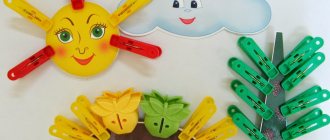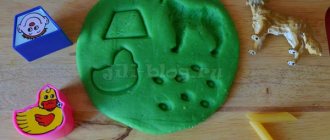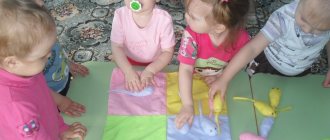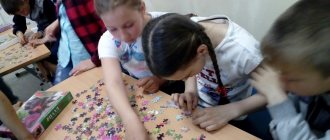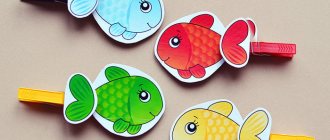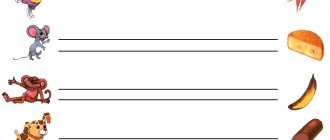Almost all parents know about the need to develop fine motor skills in children.
It stimulates the speech center, thinking and attention, helps the child prepare for school, and simplifies the development of writing. In order to help your son or daughter, it is not at all necessary to purchase expensive teaching aids or spend a lot of time on special training. A little attention, a good mood - and little fingers will gradually become skillful and dexterous, speech development will improve and new skills will appear.
Classes for children 2-3 years old
They say that everything new is well forgotten old. For the development of fine motor skills in children, the simplest games that have been played with children for centuries are ideal:
- "Magpie-crow." Take the child’s finger in your hand and move it along the palm of his other hand, telling the famous little rhyme. Then bend his fingers - “I gave to this, I gave to this.” In this way, a light massage of the nerve endings in the palm is performed and coordination of movements of individual fingers is developed. Teach your child to play magpie on his own.
- “Finger, finger, where have you been?” This game is built on the same principles. It is very important that the child learns to bend his fingers one at a time, regardless of the others.
- For massage, speech therapists often use special balls with plastic “spine” protrusions or spiral elastic bands. And you take ordinary cones. Show your child how to roll it between your palms, spin it, toss it and catch it. This is how you can not only play while walking, but also talk about nature, learn how pine and spruce cones differ, and also stimulate fine motor skills.
- Let's play Cinderella? Let your child sort through the beans - for example, offer to select the white ones from the red ones. At the same time, tell me a fairy tale.
From 1 year: first self-care skills
- Spoon, toothbrush, comb. By the age of one year, they definitely end up in the baby’s hand. They not only allow you to practice self-care skills, but also develop coordination and fine motor skills. By kindergarten we learn how to fasten and unfasten Velcro and buttons on shoes or clothes, and lace up shoes.
- Laces, beads. There are many beautiful lacings in stores, from simple ones (you can try them as early as a year) to complex ones (not earlier than 3 years). You can get by with a piece of cardboard with holes made in it, the main thing is to find a cord with a thick and durable tip or a wooden needle. Beads also don’t have to be bought in the form of ready-made sets - you can cut rings from felt and string them onto ribbons. Such simple and affordable material as dry tube pasta (penne, rigatoni, cannelloni - usually indicated on the package) is also used. It’s good if such activities are daily: they perfectly develop sensorimotor coordination, eye, attention, perseverance, and prepare the hand for writing. They are successfully used as a favorite work material for children in kindergartens working according to the Maria Montessori system.
- Home activities: “knead the dough”, select buttons of different colors and sizes, sort out the cereals, engage in “picking berries” (picking one pea at a time, holding those already collected in the palm of your hand until a full handful), scatter small cereals on a tray and let the child draw on With her finger, lines, objects, letters. Games with clothespins. We pour the cereal - with a spoon, with our hands, in glasses, look for objects hidden in it, and prepare soup for the dolls. We learn to collect water from the table with a sponge and wring out the sponge. We take out small objects from the dish with a spoon (first a table spoon - this is easier - then a tea spoon). Use a spoon to catch small objects from the water. We carry small balls in a spoon around the room. Pour the water into cups (ideally, play in the bathtub while bathing).
- Developmental centers, boards, mats - panels on which hooks, fasteners, locks, buttons, switches, zippers, latches, etc. are attached - for training the accuracy and strength of movements. Also from Maria Montessori's system.
What can you play?
- At this age, creativity occupies a large place in children's activities. Drawing with paints, pencils and crayons, modeling, designing - all these activities not only stimulate imagination, spatial thinking and attention, but also develop hand motor skills. If your child loves creative activities, that’s great; if not, try to captivate him yourself and come up with interesting tasks. For example, drawing with blots, cotton swabs, shading, coloring three-dimensional toys, creating cards as gifts for family members.
- Shadow theater is a great idea for children's entertainment and development. Remember your childhood and show your child how to fold your palms to make a cockerel, a dog, a hare, etc. Come up with a fairy tale about them together. Here's a great activity for speech development.
- Playing in the sandbox is by no means the exclusive prerogative of children. At 4-5 years old, children can already do much more than just make Easter cake. Organize the construction of a real castle in your yard with a moat, roads, decorations and more. Precise and coordinated finger actions perfectly stimulate motor skills. A walk will be beneficial not only for health, but also for development.
- Summer is over and it's winter outside? This does not mean that there is nowhere to study. Get ready for the New Year together! Wrapping nuts in foil, rolling pieces of cotton wool into “snow” balls, wrapping gifts - all this is a great opportunity to develop fine motor skills and create a joyful pre-holiday mood. Cut out snowflakes together, draw on the windows with toothpaste - these activities will bring great joy to your child, and you will be pleased with the development of your treasure.
Pay attention to the development of logical and creative thinking in children, as well as the development of phonemic awareness.
From 1 year: natural materials
- Sand games: buckets, molds, shovel, Easter cakes. A lesson for several seasons. At first, your mother (grandmother, nanny) will make the molds. We recommend starting with large molds: with their help you can make even shapes without crumbling edges (any “imperfection” can make kids angry; they strive for ideals in everything).
- Plasticine, plastic clay, salt dough. We roll sausages, make koloboks, strings and glue them into a hoop. Such activities perfectly strengthen the muscles of the hand, make the fingers more dexterous and mobile, and expand the child’s ideas about his capabilities. At a later age, your child will proudly bring figurines of hedgehogs, bunnies and dogs from kindergarten classes, which will begin to settle on your bookshelves. You cannot treat them with disrespect - these are the first products of a child’s labor, he values them very much!
- Cones, pebbles, sand, pebbles, walnuts (in shell) and chestnuts. The latter are collected during a walk in the fall, stuffed into pockets, brought home and washed. Now it’s useful to knead them in your palms, two at a time, and rotate one around the other.
- Games with any bulk materials. The child puts his hands into a vessel with some homogeneous filler (sand, various grains, pellets, any small objects). Stirs the contents for a few minutes. Then he is offered a vessel with a filler of a different texture. After several trials, the child, with his eyes closed, puts his hand into the offered vessel and tries to guess its contents without feeling its individual elements with his fingers. At the same time we develop speech. Do this only under the supervision of an adult: small objects are not recommended for children under 3 years of age to play with.
Invite your child to play “Cinderella” - sort beans, peas, large beads, dry pasta of different colors into different containers.
Classes for children 6-7 years old
Your child will soon go to school. But you shouldn’t rely only on training courses for preschoolers. There the child will be taught letters and counting, but the main thing is a solid foundation. Fine motor skills training reaches a new level:
- It's time to involve your son or daughter in helping around the house. For children, you can get a special knife that they could not get hurt with, and let them participate with their mother in cooking. Cutting boiled vegetables is not difficult, but in this way your fingers will become more skillful, and the necessary skills will be instilled by themselves.
- Dad can show you how to use a screwdriver. Tightening screws and screws will also benefit motor skills. The child can be asked to choose the necessary nails, nuts and other small parts from the box.
- Teach children to weave wreaths, braids for dolls, make beads and other decorations.
- A good activity that develops logic and is useful for developing finger coordination is laying out figures from matches, solving problems with counting sticks.
We have offered the simplest activities that will help stimulate the development of fine motor skills in a child in basic living conditions. As they say, without leaving household chores. However, undoubtedly, many families also have special toys and aids for children's development. Don't underestimate them. Depending on the child's age, use:
- All kinds of mosaics and puzzles. For kids, choose sets with large parts; as they master them, purchase smaller and more complex ones.
- Sorters, pyramids, inserts and frames.
- Kits for creativity, making jewelry and crafts.
- Books with stickers.
- Various board games aimed at controlling hand movements. For example, the game “Jenga” and its more childish version “Jolly Hippopotamus” are very popular, in which you need to carefully pull out sticks or blocks so as not to drop the constructed structure. By the way, adults will also enjoy playing Jenga.
Involve your children in your activities and find time to play together. Good family relationships and an intelligent, developed child will be your reward.
Publication date: 11/15/2016. Last modified: 05/09/2018.
Guessing pictures and textures by touch
Remember, in the article about games for the development of motor skills from 2 years old, I mentioned the game “Magic Bag”. This activity, as a rule, always goes off with a bang! Because it contains an element of surprise, and children love this passion. But it is worth noting that in addition to positive emotions, the game also stimulates sensory perception, because in the process of playing the child learns to identify objects by touch.
If you have already mastered the tactile games from the previous article, I suggest you try more advanced options for developing sensory sensations.
Option 1. Tactile pictures
You can make tactile pictures yourself using velvet colored paper (it is sold at any stationery store). To do this, cut out silhouettes of simple pictures from velvet paper and paste them onto cards made of ordinary colored cardboard. Thus, the pasted picture will differ from the card itself in texture. It is also desirable that the shapes of the pictures differ noticeably from each other. I took ideas from simple coloring books I downloaded on the Internet.
When the cards are ready, let your child feel each of them first. And then ask him to close his eyes and guess by touch any of the cards you offer. Repeat the game with other cards.
Option 2. Touch lotto
Unlike regular lotto, in sensory lotto the child is asked to find the same chips not visually, but tactilely. You can buy a lotto ready-made or make it yourself, armed with a glue gun, baby food lids and various textured materials (for example, cereals, beans, pompons, velvet paper, beads, sponge). See the video for an example of a homemade lotto.
If your child has never played with tactile lotto before, then first just look and feel all the chips, discuss which ones are soft, which ones are rough, prickly, smooth, etc. And after you have studied it thoroughly, offer to play the “Magic Bag” by putting a small amount of chips into it. The child’s task is to find in the bag by touch exactly the same chip that you show him.
Assembling pictures by overlaying elements
Despite the fact that to prepare this game you only need a marker and sour cream lids, it develops spatial and logical thinking no worse than the well-known Bondibon. Therefore, stock up on sour cream and get started!
What is the essence of the game? The child needs to assemble a whole picture from individual parts drawn on the lids. This is a completely new problem for a child’s spatial thinking, because when playing with blocks or construction sets, he is used to getting a certain image or shape by putting the parts together. Here the picture will be obtained by superimposing transparent parts on top of each other.
To play the game, you will need to prepare several simple picture diagrams and draw the corresponding elements on the transparent covers. For example, on one cover we draw a house, on another – a fence, on the third – the sun, on the fourth – grass. If you combine all this, you get a beautiful village landscape. Elements of different pictures must be mixed together so that the child himself can select the appropriate ones, focusing on the diagram. You can see the essence of the game in more detail in the video.
Learning to fasten buttons
As you know, the main motto of Maria Montessori’s method is “Help me do it myself.” This means that we offer the child feasible tasks to complete independently, we suggest, guide his hand, if necessary, but we try to interfere with his activities to a minimum. And this applies not only to games, but, first of all, to self-service skills. Yes, yes, even toddlers can be entrusted with simple tasks of caring for (and cleaning) themselves (eating with a spoon, fastening zippers, sweeping up crumbs with a dustpan, etc.). After all, mastering self-care skills for a child is an activity no less interesting (and useful!) than any game.
Since he was a year old, we have been asking the baby to unfasten zippers, Velcro, and unscrew lids, and we remember how the baby enthusiastically “hovered” over this activity. Well, now it’s time to trust the child to fasten the buttons on his own. Of course, it will be difficult for a child to immediately deal with the buttons on his blouse; it is better if first it is something like a button simulator, or at least your blouse with large buttons.
If you have the time and desire, then you can sew a button simulator yourself, designing it, for example, in the form of doors that close with a button, or some character with fastened clothes. Such toys will make mastering “button making” incredibly interesting for a child, because not everyone immediately wants to pick up a jacket
You can also look for ready-made button exercise machines that are currently on sale.
While playing, explain that it is more convenient to hold the button with your thumb and forefinger, first pointing one side of it into the loop. Hinged hinges are usually more difficult for a child to master, so start with slotted ones.
Playing with small mosaic pieces
Any mosaic is an excellent trainer for a child’s fine motor skills. And if earlier, a year, one of the child’s main toys was a mosaic with large chips, now he can be offered a mosaic, which many of us probably remember from childhood - with small details on tiny legs (Ozon, My-shop, KoroBoom ).
The very process of pushing the thin plastic legs into the tiny holes is very exciting for the baby. There is no need to rush the child by asking him to immediately draw a picture; let him calmly learn a new skill. And when the construction of abstract images is already easy, try to involve your child in the construction of paths and simple figures.
Taisiya liked most of all to build bridge paths between two small toys placed at the edges of the playing field. The paths may not be of chaotic colors, but with a certain pattern (alternating colors through 1, through 2 or more complex patterns) - this is how we immediately develop logical thinking.
